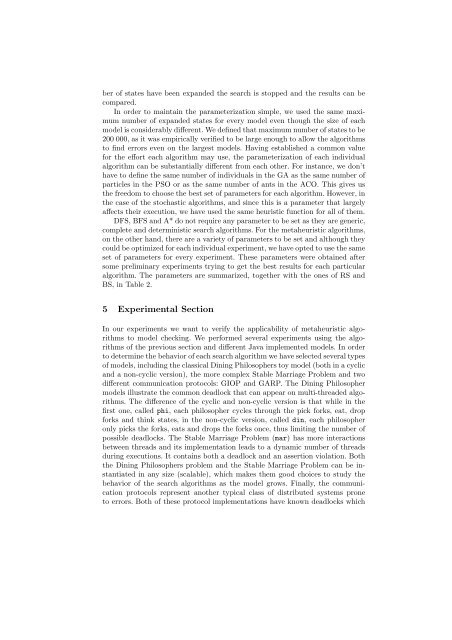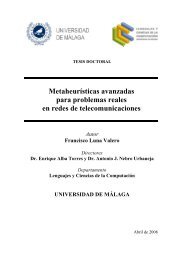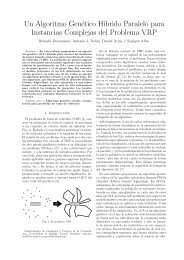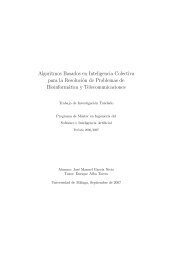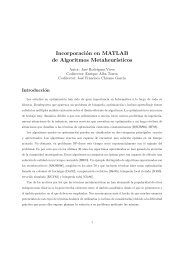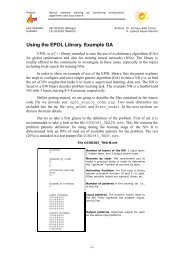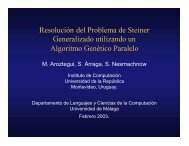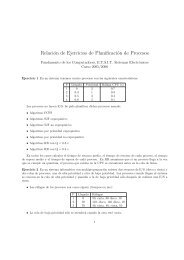Comparing Metaheuristic Algorithms for Error Detection in ... - NEO
Comparing Metaheuristic Algorithms for Error Detection in ... - NEO
Comparing Metaheuristic Algorithms for Error Detection in ... - NEO
You also want an ePaper? Increase the reach of your titles
YUMPU automatically turns print PDFs into web optimized ePapers that Google loves.
er of states have been expanded the search is stopped and the results can be<br />
compared.<br />
In order to ma<strong>in</strong>ta<strong>in</strong> the parameterization simple, we used the same maximum<br />
number of expanded states <strong>for</strong> every model even though the size of each<br />
model is considerably different. We def<strong>in</strong>ed that maximum number of states to be<br />
200 000, as it was empirically verified to be large enough to allow the algorithms<br />
to f<strong>in</strong>d errors even on the largest models. Hav<strong>in</strong>g established a common value<br />
<strong>for</strong> the ef<strong>for</strong>t each algorithm may use, the parameterization of each <strong>in</strong>dividual<br />
algorithm can be substantially different from each other. For <strong>in</strong>stance, we don’t<br />
have to def<strong>in</strong>e the same number of <strong>in</strong>dividuals <strong>in</strong> the GA as the same number of<br />
particles <strong>in</strong> the PSO or as the same number of ants <strong>in</strong> the ACO. This gives us<br />
the freedom to choose the best set of parameters <strong>for</strong> each algorithm. However, <strong>in</strong><br />
the case of the stochastic algorithms, and s<strong>in</strong>ce this is a parameter that largely<br />
affects their execution, we have used the same heuristic function <strong>for</strong> all of them.<br />
DFS, BFS and A* do not require any parameter to be set as they are generic,<br />
complete and determ<strong>in</strong>istic search algorithms. For the metaheuristic algorithms,<br />
on the other hand, there are a variety of parameters to be set and although they<br />
could be optimized <strong>for</strong> each <strong>in</strong>dividual experiment, we have opted to use the same<br />
set of parameters <strong>for</strong> every experiment. These parameters were obta<strong>in</strong>ed after<br />
some prelim<strong>in</strong>ary experiments try<strong>in</strong>g to get the best results <strong>for</strong> each particular<br />
algorithm. The parameters are summarized, together with the ones of RS and<br />
BS, <strong>in</strong> Table 2.<br />
5 Experimental Section<br />
In our experiments we want to verify the applicability of metaheuristic algorithms<br />
to model check<strong>in</strong>g. We per<strong>for</strong>med several experiments us<strong>in</strong>g the algorithms<br />
of the previous section and different Java implemented models. In order<br />
to determ<strong>in</strong>e the behavior of each search algorithm we have selected several types<br />
of models, <strong>in</strong>clud<strong>in</strong>g the classical D<strong>in</strong><strong>in</strong>g Philosophers toy model (both <strong>in</strong> a cyclic<br />
and a non-cyclic version), the more complex Stable Marriage Problem and two<br />
different communication protocols: GIOP and GARP. The D<strong>in</strong><strong>in</strong>g Philosopher<br />
models illustrate the common deadlock that can appear on multi-threaded algorithms.<br />
The difference of the cyclic and non-cyclic version is that while <strong>in</strong> the<br />
first one, called phi, each philosopher cycles through the pick <strong>for</strong>ks, eat, drop<br />
<strong>for</strong>ks and th<strong>in</strong>k states, <strong>in</strong> the non-cyclic version, called d<strong>in</strong>, each philosopher<br />
only picks the <strong>for</strong>ks, eats and drops the <strong>for</strong>ks once, thus limit<strong>in</strong>g the number of<br />
possible deadlocks. The Stable Marriage Problem (mar) has more <strong>in</strong>teractions<br />
between threads and its implementation leads to a dynamic number of threads<br />
dur<strong>in</strong>g executions. It conta<strong>in</strong>s both a deadlock and an assertion violation. Both<br />
the D<strong>in</strong><strong>in</strong>g Philosophers problem and the Stable Marriage Problem can be <strong>in</strong>stantiated<br />
<strong>in</strong> any size (scalable), which makes them good choices to study the<br />
behavior of the search algorithms as the model grows. F<strong>in</strong>ally, the communication<br />
protocols represent another typical class of distributed systems prone<br />
to errors. Both of these protocol implementations have known deadlocks which


